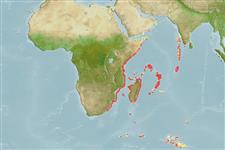Environment: milieu / climate zone / depth range / distribution range
Ecología
marino batidemersal; rango de profundidad 250 - 450 m (Ref. 6270). Deep-water
Western Indian Ocean: Kenya to Natal, South Africa. Unconfirmed record from Taiwan (Ref. 9792).
Tamaño / Peso / Age
Maturity: Lm ? range ? - ? cm
Max length : 15.0 cm TL macho / no sexado; (Ref. 9792)
Espinas dorsales (total): 0; Radios blandos dorsales (total): 60-62; Espinas anales 0; Radios blandos anales: 51 - 54. Eyed side greyish brown; dorsal, anal and pectoral fins dusky to black; 2 dark blotches on caudal fin; blind side pale with dusky spots (Ref. 6270). Pectoral fin rays on ocular side 8-7, blind 7-10. Body depth, length 2.5-2.8 times the depth (Ref. 41434).
Feeds on small benthic animals (Ref. 9792).
Life cycle and mating behavior
Madurez | Reproducción | Puesta | Huevos | Fecundidad | Larva
Heemstra, P.C., 1986. Pleuronectidae. p. 863-865. In M.M. Smith and P.C. Heemstra (eds.) Smith's sea fishes. Springer-Verlag, Berlin. (Ref. 6270)
IUCN Red List Status (Ref. 130435)
Threat to humans
Harmless
Human uses
Pesquerías: sin interés
Más información
Nombres comunesSinónimosMetabolismoDespredadoresEcotoxicologíaReproducciónMadurezPuestaAgregación para la puestaFecundidadHuevosEgg development
ReferenciasAcuiculturaPerfil de acuiculturaRazasGenéticaElectrophoresesheritabilidadEnfermedadesProcesamientoNutrientsMass conversion
Herramientas
Special reports
Download XML
Fuentes de Internet
Estimates based on models
Preferred temperature (Ref.
123201): 11.5 - 14.7, mean 13 °C (based on 21 cells).
Phylogenetic diversity index (Ref.
82804): PD
50 = 0.5000 [Uniqueness, from 0.5 = low to 2.0 = high].
Bayesian length-weight: a=0.01995 (0.00906 - 0.04395), b=3.01 (2.83 - 3.19), in cm total length, based on all LWR estimates for this body shape (Ref.
93245).
Nivel trófico (Ref.
69278): 3.5 ±0.37 se; based on food items.
Resiliencia (Ref.
120179): Medio, población duplicada en un tiempo mínimo de 1.4-4.4 años (Assuming tmax>3).
Fishing Vulnerability (Ref.
59153): Low vulnerability (10 of 100).
